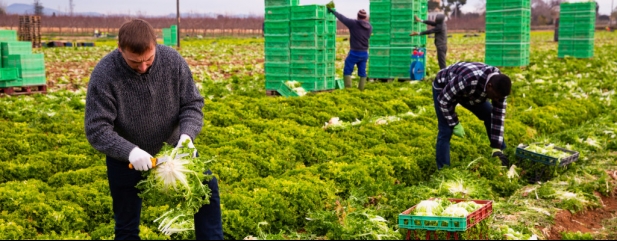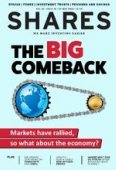Archived article
Please note that tax, investment, pension and ISA rules can change and the information and any views contained in this article may now be inaccurate.
Should we be worried about food security?

Food prices are likely to go up as a result of pressure on the food supply chain linked to the coronavirus pandemic. Companies who can get food products to the consumer, either manufacturers supplying retailers or supermarkets being able to provide adequate stocks, could be winners from an investment perspective.
We’ll discuss the situation in this article along with two stock ideas to play the theme.
WHAT’S HAPPENING?
According to Global Food Security, the UK cross-government programme on food security research, of the 4m people working in the food supply chain around 500,000 are directly involved in farming and fishing, with another 400,000 employed in food manufacturing.
The supply chain is extremely sensitive to environmental and economic events. Too much or too little rain can ruin harvests, while disease can devastate livestock herds. Climate change has raised the threat of more frequent catastrophic weather and the spread of disease.
On top of these threats, an unprecedented sudden surge in demand as experienced in March this year can result in the system grinding to a halt as stores struggle to replenish shelves stripped bare by panic buying.
MEMORIES OF 2008
Early 2008 saw the culmination of a 12-month surge in fresh and ambient food prices which brought to an end decades of falling relative prices of food in the UK.
Triggered by a global shortage, rice prices increased by 75% and wheat prices by 130%, even though the UK produced a record crop of 17m tonnes of wheat. Fruit and vegetable prices increased by up to 30% and some processed foods increased by more than 40%.
Fast forward to today, with restrictions on social mobility across Europe and many parts of the world, getting food from the farm to the plate is likely to mean prices rise again.
LABOUR ISSUES
In Europe, the governments of France, Germany, Italy and Spain have appealed for up to a million seasonal workers to pick fruit and vegetables.
In Belgium, the government has asked the population to eat an extra portion of ‘frites’ at home every week to avoid farmers having to destroy an estimated 750,000 tonnes of surplus potatoes caused by the closure of restaurants and the food-service industry.
The UK farming industry has asked for 80,000 British fruit and vegetable pickers, but the recruitment drive failed spectacularly after just 112 people out of 50,000 applicants took up roles.
The harsh reality of weeks of back-breaking work picking crops in all weathers for minimum wage clearly didn’t appeal. Instead the UK Government has flown in hundreds of experienced pickers from Romania, who are typically more efficient, but there is still nowhere near the amount of labour needed.
Alan Guindi, managing director of Richard Hochfeld, one of the UK’s leading growers and importers of fruit, points to ‘a steady decline in seasonal workers since 2016, which is getting worse’.
The firm has taken extraordinary measures to guarantee supplies, the most drastic of which has been vertical integration. ‘We have become the source,’ says Guindi. ‘We have invested in farms in other countries, formed joint ventures with existing suppliers and invested in farmland and innovation all to ensure supply. For the rest of our supply we have had to offer advances to growers, or lose product to countries also procuring the food we need.’
HOME COOKING
It’s hard to overstate the scale of the shift to in-home consumption of food since the lockdown and the closure of restaurants and other eateries.
Supermarket giant Tesco (TSCO) reported a 50% jump in food sales in March and although the rate of increase has moderated, demand is still substantially higher than it was pre-crisis.
According to consultant Kantar Worldpanel, out-of-home consumption would typically have accounted for 30% to 40% of the UK’s calorie consumption, with over half of the population eating lunch outside of home.
With the lockdown, Kantar estimates that the amount of in-home meals is set to increase by almost 40% or more than 500m, resulting in an increase in spending of over £670m.
While we may be making fewer trips to the supermarket under lockdown, spending on food has risen more than 50%, offsetting the lower footfall.
Also, despite the success of ‘Veganuary’ and the trend towards meat alternatives, the demand for meat and poultry is rising with more meals being prepared and eaten at home.
SUPPLY DISRUPTION
In the US, the meat industry is in crisis after coronavirus caused the shutdown of meat processing plants, creating shortages at grocery stores.
Almost a third of pork capacity is down, leading to huge price rises in ham, bacon and even hot dogs. John Tyson, chairman of Tyson Foods, warned that ‘the food supply chain is breaking’.
The party line from the British Retail Consortium (BRC) and the supermarkets is that, despite the lack of fruit and vegetable pickers and problems in other countries, there is no food security issue in the UK.
Andrew Opie, director of food and sustainability at the BRC, says: ‘The Government is working with major UK growers to ensure the availability of essential workers and a continued supply of fresh fruit and vegetables in the coming months.’
Tesco has absorbed the oversupply of a number of products which would normally go to the fast-food or restaurant industry, such as eggs, poultry and potatoes, and has promoted UK and Irish beef to help suppliers manage their inventories.
Morrisons (MRW) tells Shares: ‘More than two thirds of the food we sell is British; that includes all of our fresh meat and we have 18 food manufacturing sites producing British food. Additionally, we are the largest supermarket customer for British farmers.’
Gareth Davies, chief executive of agricultural supplies firm Wynnstay (WYN:AIM), believes there is a strong argument for improving the UK’s food self-sufficiency, after the coronavirus pandemic ‘highlighted the potential problem of global supply chains’.
TWO STOCKS TO BUY
Cranswick (CWK) £36.38
The premium meat producer is ideally placed to benefit from the trend towards in-home consumption and increased spending on quality treats. Consultant Kantar Worldpanel estimates that in-home meals will rise by 38% to 503m per week during the period of lockdown.
One of the key attractions for retailers and consumers alike is the provenance and security of Cranswick’s supply chain, which reflects many years of investment aimed at improving animal welfare and protecting the environment.
The pork-to-poultry supplier is expected to produce strong results on 23 June with sales growth of 14% for the year to 31 March forecast by analysts.
With strong cash flows, Cranswick is well positioned to grow and to maintain high returns on capital in the 18% to 20% range.
Hilton Foods (HFG) £11.64
Investor appetite for this global food packer has proved ravenous since the world entered lockdown, reflecting its ability to keep supermarket shelves stocked with meat and fish and consumers fed.
Shares believes Hilton’s resilience and robust balance sheet will see it thrive during the coronavirus crisis.
Hilton packs proteins for retailers including Tesco, Ahold Delhaize and Woolworths in Australia at state-of-the-art plants using automation and robotics.
The global pandemic has emphasised the strength of its relationships with major retailers, with Hilton’s global sourcing capabilities enabling confidence in the supply chain.
Furthermore, a focus on pre-packed products means the company should benefit from a shift away from counter serving to packaged foods, as retailers recognise the benefits of lower costs, less waste and fewer cases of contact with consumers.
A FUTURE OF RISING PRICES
In a sequence of events which no-one could have predicted, the sudden fall in oil prices forced many bioethanol plants to stop production as the market price fell below their output cost.
This created a shortage of distillers grains, a byproduct of bioethanol used in animal feed, sending prices soaring, which in turn sent rapeseed meal prices up.
Similarly, the government lockdown in Argentina – one of the world’s major producers of soya, another important animal feedstock – combined with strikes at some ports, saw prices spike on world exchanges.
According to Richard Whiting, chief executive of feed, food and fuel distribution group NWF (NWF:AIM), the pandemic caused a great deal of strain on supply chains, and the additional cost of adopting social distancing measures has been significant across the food industry.
While the ambient food supply chain is now well placed to handle any future shocks, the great unknown for fresh food producers and distributors – and ultimately consumers – is what happens post-Brexit.
Wynnstay’s Davies says: ‘After Brexit there will be no issue in receiving food or goods from Europe because supply routes will remain open, but any form of additional delay or regulation will add to costs. This will either be absorbed by the end user or the primary producer.’
Hochfeld’s Guindi agrees, commenting: ‘The weak pound, more checks on products at ports – which will slow down the supply chain and impact shelf life – together with higher transport and logistics costs mean inflation is inevitable. The consumer will bear the brunt of it.’
Whiting at NWF says if the UK wants to maintain its ‘current high standards of food safety and animal welfare’, and refuses to compromise in pursuit of new trade deals, prices will have to rise.
Looking beyond Brexit, as China and other developing countries become more affluent and their consumers demand products of a similar standard to developed nations, competition for goods will increase, putting yet more upward pressure on prices.
Important information:
These articles are provided by Shares magazine which is published by AJ Bell Media, a part of AJ Bell. Shares is not written by AJ Bell.
Shares is provided for your general information and use and is not a personal recommendation to invest. It is not intended to be relied upon by you in making or not making any investment decisions. The investments referred to in these articles will not be suitable for all investors. If in doubt please seek appropriate independent financial advice.
Investors acting on the information in these articles do so at their own risk and AJ Bell Media and its staff do not accept liability for losses suffered by investors as a result of their investment decisions.
Issue contents
Editor's View
Feature
First-time Investor
Great Ideas
Money Matters
News
- Exit charge lowered on Lifetime ISA as a temporary measure
- Companies will need to start quantifying Covid-19 impact
- Investors need to be prepared for terrible second quarter results
- Why these stocks have just hit all-time highs
- Orbis seeing ‘most exceptional discounts’ since the credit crunch
- Could we see a return of M&A due to the crisis?
- Berkshire Hathaway builds cash to record levels, sell airline stocks

 magazine
magazine












